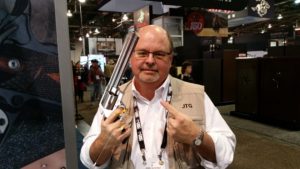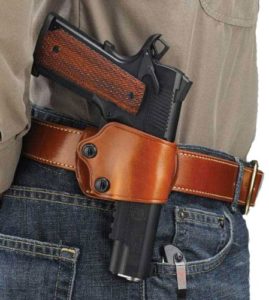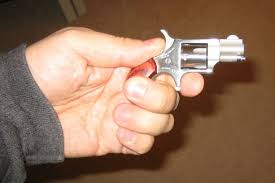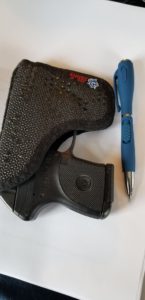In the comments section of my most recent gun porn post, our own Jordan Dane gave me the idea of doing a post on how a character–particularly a female character–would go about choosing which handgun to carry. Way to tee one up for the Johnster!
Caliber (and caliber snobs)
As I’ve discussed here before, “caliber” refers to the diameter of a bullet at its widest point, measured in inches or millimeters. (Note: in the parlance of people who know guns, the word caliber is exclusively used in reference to measurement in inches. One would never say “nine millimeter caliber,” but one would say “.38 caliber.”)
If you hang out at some of the corners of the Internet that I visit from time to time, you’ll learn that there’s a very vocal element out there that states without equivocation that any caliber that doesn’t start with a 4 or larger isn’t worth carrying. They’ll talk about “stopping power” and “lethality” and hold in contempt anyone who is not willing to strap a two-pound hand cannon to their belt. I call these bloviators caliber snobs, and believe their claims to fall within the broad category known as Bravo Sierra.
I’ve previously posted on how bullets do their damage. You’re sending a hunk of metal through vulnerable parts of your target’s anatomy. If it hits the appropriate anatomy, the result is reasonably predictable. In almost all cases, a poorly aimed mini-cannonball does far less damage than a well-placed .22. Have your character choose a weapon s/he can reasonably control.
Ultimately, selection comes down to manageability. This leads us to…
My friend Isaac Newton
Newton’s three laws of motion are:
1. An object at rest tends to stay at rest.
2. The acceleration of an object is affected by two factors: the force applied; and the object’s mass.
3. Every action has an equal and opposite reaction.
Sooo . . . Heavier bullets need more force to get them out of the barrel and on their way. Greater force creates greater recoil. For any given caliber of firearm, the heavier the gun, the less recoil felt by the shooter. The greater the felt recoil, the more likely the shot will be off-target. There are lots of reasons for this, but for our purposes here, it boils down to the shooter getting what I call the yips. They anticipate the punch to the hand and they screw up their aim.
 There’s such a thing as a Smith & Wesson .500 magnum. Pictured here from the SHOT Show in Las Vegas, this four-pound smoke wagon fires bullets at over 1,800 feet per second (FPS) and, according to the manufacturer, will drop an elephant. I’ve shot this beast. While it’s the kind of pistol that a new Dirty Harry might be drawn to (“the most powerful handgun in the world and can blow your head clean off–while you’re hiding behind the refrigerator in your neighbor’s house“), there’s no practical use for it in the hands of your private detective.
There’s such a thing as a Smith & Wesson .500 magnum. Pictured here from the SHOT Show in Las Vegas, this four-pound smoke wagon fires bullets at over 1,800 feet per second (FPS) and, according to the manufacturer, will drop an elephant. I’ve shot this beast. While it’s the kind of pistol that a new Dirty Harry might be drawn to (“the most powerful handgun in the world and can blow your head clean off–while you’re hiding behind the refrigerator in your neighbor’s house“), there’s no practical use for it in the hands of your private detective.
Barrel length matters.
A firearm is a pressure chamber, the sole purpose of which is to contain the pressure of the exploding gunpowder long enough to send a projectile on to its target. As the bullet proceeds down the barrel, the lands and grooves of the rifling impart a spin that stabilizes the bullet in flight. The more time the pressure has to push the bullet, the longer the bullet has time to stabilize from the lands and grooves. Thus, all else being equal, longer barrels equal greater accuracy at greater distances.
So, what kind of gunfight does your character anticipate? Most gunfights play out in less than five seconds at distances of less than ten feet. If that’s most likely your character’s world, then shorter barrels will do.
NOTE: There’s such a thing as the “21-foot rule,” which proclaims that any shot fired at a person from a range of greater than 21 feet–seven yards–is not considered self defense against any threat that is not another firearm. If a bad guy is running at your good guy with a baseball bat or a knife, many jurisdictions will say that threat is not lethal until the bad guy closes to within 21 feet.
Single-stack or double-stack?
 Guns for everyday carry (EDC) are getting smaller, but there remains a need for ammunition to feed them. As you probably know, ammo magazines for pistols typically reside in the weapon’s grip. A “single-stack” magazine stacks the bullets directly on top of each other, while a “double-stack” mag staggers the bullets side-by side, with the effect of making the grip thicker and harder to hold for a shooter with a smaller hand. The pistols shown side-by-side in the picture are the Glock 26 on the left, and the Glock 43 on the right. Both are called “baby Glocks”, with barrel lengths within a couple hundredths of 3.4 inches. They’re called compact 9mm pistols. The one on the left (G26) is fed by a double-stack magazine and holds 10 rounds, plus one in the chamber, while the one on the right (the G43) uses a single-stack mag and holds 6 rounds plus one in the pipe. You need to ask yourself what your character’s priorities are. Those four extra rounds cost you a lot in terms of grip size and concealability. (Full disclosure: having spoken to many people who’ve been involved in gunfights, I’ve never heard one complain about having too much ammunition.)
Guns for everyday carry (EDC) are getting smaller, but there remains a need for ammunition to feed them. As you probably know, ammo magazines for pistols typically reside in the weapon’s grip. A “single-stack” magazine stacks the bullets directly on top of each other, while a “double-stack” mag staggers the bullets side-by side, with the effect of making the grip thicker and harder to hold for a shooter with a smaller hand. The pistols shown side-by-side in the picture are the Glock 26 on the left, and the Glock 43 on the right. Both are called “baby Glocks”, with barrel lengths within a couple hundredths of 3.4 inches. They’re called compact 9mm pistols. The one on the left (G26) is fed by a double-stack magazine and holds 10 rounds, plus one in the chamber, while the one on the right (the G43) uses a single-stack mag and holds 6 rounds plus one in the pipe. You need to ask yourself what your character’s priorities are. Those four extra rounds cost you a lot in terms of grip size and concealability. (Full disclosure: having spoken to many people who’ve been involved in gunfights, I’ve never heard one complain about having too much ammunition.)
Dress for the day.
How likely is it that your character will get involved in a gunfight?  Military personnel in a war zone, and police officers on duty carry full-size pistols because there’s a reasonably high likelihood that they will find themselves in a gunfight. They make no effort to conceal their firearm, so bigger is better. The bigger, heavier platform is less punishing to shoot, and as a result, accuracy tends to be better. But it’s not exactly the right weapon to strap to your tuxedo or evening gown on the way to the opera.
Military personnel in a war zone, and police officers on duty carry full-size pistols because there’s a reasonably high likelihood that they will find themselves in a gunfight. They make no effort to conceal their firearm, so bigger is better. The bigger, heavier platform is less punishing to shoot, and as a result, accuracy tends to be better. But it’s not exactly the right weapon to strap to your tuxedo or evening gown on the way to the opera.

North American Arms Mini-Revolver chambered in .22 short. The effective range is maybe 4 or 5 feet, but fired into the brain pan, it’s as deadly as a sniper shot.
For those highly concealed applications, the firearm manufacturing industry offers lots of options. Just remember that for any given caliber, the smaller and lighter the weapon–the easier it is to carry and conceal–the more punishing it is to shoot. Also, smaller guns mean a shorter effective range.
 One of the most popular EDC guns on the market these days is the Ruger LCP (Lightweight Compact Pistol), chambered in .380, shown here in the picture next to the ballpoint pen to give it scale. As presented, the pistol is in a pocket holster, which is exactly what it sounds like–a holster that slides easily into a pocket or a purse. Because of its tiny size–there’s only room for two fingers on the grip–and its very heavy trigger pull, this is a difficult gun to learn to shoot, but once you get the hang of it, it’s pretty effective. Virtually every gun manufacturer makes a similar weapon, and all of them are hand-breakers till you learn the right grip.
One of the most popular EDC guns on the market these days is the Ruger LCP (Lightweight Compact Pistol), chambered in .380, shown here in the picture next to the ballpoint pen to give it scale. As presented, the pistol is in a pocket holster, which is exactly what it sounds like–a holster that slides easily into a pocket or a purse. Because of its tiny size–there’s only room for two fingers on the grip–and its very heavy trigger pull, this is a difficult gun to learn to shoot, but once you get the hang of it, it’s pretty effective. Virtually every gun manufacturer makes a similar weapon, and all of them are hand-breakers till you learn the right grip.
Okay, TKZers, how do you want to arm your good guys? How about your bad guys? What other questions do you have?

That’s my baby.
I don’t find it difficult to shoot, but I choose my weapons based largely on how they feel in my hand. I have small hands. It’s a good fit for me.
One thing to keep in mind – if your character has had Lasik, it could affect their shooting. My shooting eye changed. That was unexpected (another reason to go to the range – find these things out before you need it).
Cynthia, thanks for adding this interesting tidbit about Lasik. I didn’t know that.
Excellent piece, John, and thanks for posting. I nearly choked on my morning coffee when I saw both the .500 Magnum and the North American Arms Mini-Revolver. The latter looks like something you’d get in a box of Cracker Jacks. And that Magnum needs a pair of wheels.
Question, please: I’ve seen contradictory opinions about a gun fired underwater or in outer space. I thought the casing contained enough oxygen to permit an explosion, but I’ve been told that’s not true. Any thoughts? Thank you!
Great post, John. Being a thick-wristed, medium-hand-size guy, in my youth I loved playing with hand cannons. The Colt 1911 .45 was my baby, followed closely by the old S&W .357 Model 19.
Nowadays, I much prefer my M9 9mm Beretta but I agree, as you hinted at, that size has little bearing if you’re accurate.
Harvey, I know that I am in the minority, but I’m not a fan of the M9. I’ve got a couple of Berettas in my collection, and I respect their engineering. I even like the double-single action of the M9. It’s just too much iron for my tastes.
The propellant used in modern bullets has oxidizer in the mix. No atmospheric oxygen is necessary.
Thanks, John. Very helpful post.
Any way – when you’re researching a gun – to find its recoil measured in standardized measurement so that you can compare guns?
Not that I’m aware of, Steve. The energy emitted by any given bullet is a constant for that brand, and is easily researched. From there, I guess you could use the weight of the gun to extrapolate a number for felt recoil, but I don’t know how to do that.
There are other factors that affect felt recoil as well, not least of which is the relationship of barrel position and hand position. The higher the barrel relative to the shooter’s grip, the snappier the gun.
I love your gun posts! Bravo Sierra, LOL!
Thanks, Philip. 😀
Thanks, John–especially the reminder about Newton’s three laws. We see on TV programs and read in certain novels about protagonists shooting without being fazed by recoil. Doesn’t work that way, and we need to keep that in mind when choosing a weapon for our hero/heroine.
Thanks, Doc. On the flip side, we see a lot of shooting victims being propelled through the back wall by a shotgun blast. Ah, physics. More people should have paid attention in class.
I remember you talked about that before but don’t remember the argument. Is it because the pellets penetrate, and lose their energy that way, that they don’t do any shoving?
It’s because there’s never enough energy to impart that kind of force. The felt recoil is the most linear force that anyone in that exchange will feel. That said, all the penetrating force will be absorbed on the receiving end, but that force will be absorbed.
A nostalgic, off-topic moment: I grew up when Roy and Hopalong and John had 77 shooters–they could shot all picture long and never run out of ammunition.
I appreciate your posts.
Thanks for that, Jim. When I was a kid playing guns, we would actually declare that we had “bullet makers” in our guns, just so we could avoid the inconvenience of reloading.
No Bravo Sierra here. Thanks for this great post on guns, John. I love the detail & the pictures. I hope you’ll continue these. You break things down in ways I haven’t heard before.
I like how you show various holsters. We’ve all seen crime shows on TV & can picture the more traditional shoulder holster, for example. But men & women would choose different holsters for different applications, like being armed while exercising or carrying concealed at a formal evening activity or something that slips easily onto any belt.
I bet someone could carry that mini-revolver in a Speedo…not that I want to picture that.
I’d have my guy carry a revolver so he could slap the magazine in easily. j/k. Except I think I remember someone telling me once that a revolver can use something called a moon clip?
Thanks for the good blog. At the very least, I hope it convinces folks to get help instead of winging it.
The moon clips I’m familiar with are adapters that allow ACP rounds to be loaded into a revolver. There are also speed loaders for revolvers, but they are pretty bulky.
Nothing wrong with a small revolver like a Smith and Wesson .22 for a stand-your-ground home invasion situation. It fits a small hand and the nightstand drawer. The bullets shouldn’t go through the house or apartment wall to hit innocents, and, frankly, if the attackers have lots of guns, you’re screwed whether you can reload fast with a automatic pistol magazine or one bullet or reload at a time.
I agree completely, Marilynn. One suggestion I would make in that scenario would be to upgrade to .22 magnum. Revolver friendly and with low recoil, the terminal ballistics are close to what you get from an often-unmanageable .38.
So you’re saying that a nine year old girl trying to get away from a killer and running into her mother’s bedroom, grabbing her mother’s .52 Desert Eagle from a purse, and pumping three rounds into the killer’s left eye as he runs toward her, may not be completely believable?
(Pause)
Note to self: Dump chapter 14.
Yep, I’m saying exactly that! 🙂
Researching weapons is one of the fun parts of writing historical thrillers. They must be appropriate for the time and place to be credible. In my latest, the bad guy, a KGB major, makes a kill shot from about a hundred meters away. He uses a Tokarev TT-30 pistol with a special load as evidenced by unmarked brass cartridges. His partner fires a Stechkin nine mil. full-auto pistol often used by Soviet Spetsnaz troops.
The mini-revolver picture reminded me of the story about the state trooper killed by a single shot from one during a traffic stop. This was after he had pumped multiple rounds from his .45 into the shooter. The shooter lived.
I always enjoy your firearms posts and usually learn something new.
A kill shot with a pistol at 100 yards is a hell of a shot, RG. I want your guy on my guy’s team!
Terrific post, John. Bookmarking!
Good post, John. I agree that the LCP is not much fun to shoot.
Can I challenge the characterization of the “21-foot rule” as an objective legal measure that constitutes legitimate/justified self-defense (“many jurisdictions will say that threat is not lethal until the bad guy closes to within 21 feet”). I’m not sure that’s the case. Many factors go into determining whether use of deadly force was justified. While it’s true that physical proximity of the threat is one factor, the “21-foot rule” is not a rule at all, and even Dennis Tueller, to whom the term is credited, never actually used that term — and has denounced the notion of “21 feet” as a “rule.”
The term arose from an article he wrote for SWAT Magazine in 1983, where he observed that a healthy male (say, armed with a blunt or edged weapon) could close a distance of 21 feet in about 1.5 seconds — which is about the same amount of time required to draw a firearm and fire two well-placed shots.
While it’s a useful training concept that defines a radius of threat (and a training concept used widely), it’s far from a “rule” or legal concept where jurisdictions would say, “at 20 feet, you’re justified in use of deadly force, but at 22 feet you are not.”
Hi, Joe. I agree with you completely when it comes to the specific number, but the larger concept holds true, especially when it comes to the civil trial that always follows the decision on whether or not to charge the shooter with a crime. The difference between 21 feet and 25 feet might not matter, but at 50 feet that baseball bat will seem significantly less lethal. At 50 yards, it would be hard to construct the argument.
Stand-your-ground laws have been so wildly (and deliberately, I think) misrepresented in popular media to be the equivalent of Western movie shootouts that I thought the concept of restraint was important to highlight here on a writer’s board.
As a side note, by the way, I was at a training class a few months ago where we pitted an edged weapons expert against an experienced SF shooter (blue gun, blue knife), and we showed the 21-foot rule to be more like a 35-foot reality.
All good points. I’m impressed with how well you’re engaging with your readers.
So…is there a gun that’s easy to conceal that’s also easy to shoot with? I could see a whole new market share for something like that!
Take a look at the Glock 42 (.380) and the Ruger LC9-S.